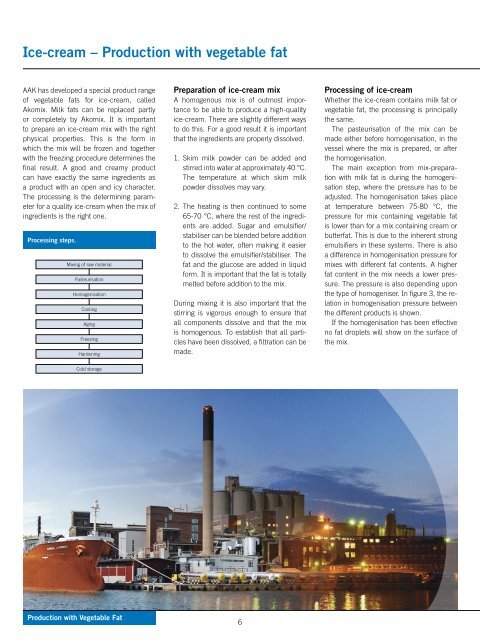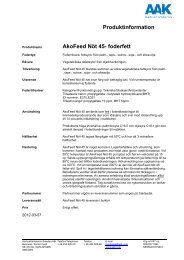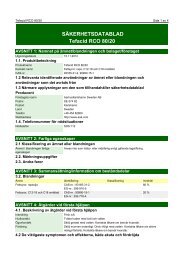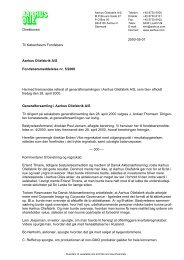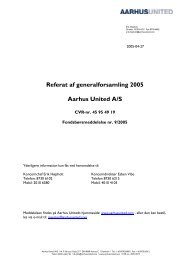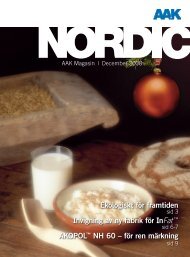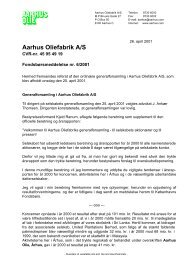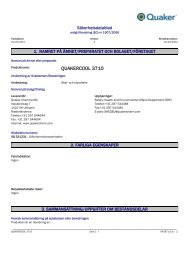Ice-cream fats - AAK
Ice-cream fats - AAK
Ice-cream fats - AAK
You also want an ePaper? Increase the reach of your titles
YUMPU automatically turns print PDFs into web optimized ePapers that Google loves.
<strong>Ice</strong>-<strong>cream</strong> – Production with vegetable fat<br />
<strong>AAK</strong> has developed a special product range<br />
of vegetable <strong>fats</strong> for ice-<strong>cream</strong>, called<br />
Akomix. Milk <strong>fats</strong> can be replaced partly<br />
or completely by Akomix. It is important<br />
to prepare an ice-<strong>cream</strong> mix with the right<br />
physical properties. This is the form in<br />
which the mix will be frozen and together<br />
with the freezing procedure determines the<br />
final result. A good and <strong>cream</strong>y product<br />
can have exactly the same ingredients as<br />
a product with an open and icy character.<br />
The processing is the determining parameter<br />
for a quality ice-<strong>cream</strong> when the mix of<br />
ingredients is the right one.<br />
Processing steps.<br />
Mixing of raw material<br />
Pasteurisation<br />
Homogenisation<br />
Cooling<br />
Aging<br />
Freezing<br />
Hardening<br />
Cold storage<br />
Production with Vegetable Fat<br />
Preparation of ice-<strong>cream</strong> mix<br />
A homogenous mix is of outmost importance<br />
to be able to produce a high-quality<br />
ice-<strong>cream</strong>. There are slightly different ways<br />
to do this. For a good result it is important<br />
that the ingredients are properly dissolved.<br />
1. Skim milk powder can be added and<br />
stirred into water at approximately 40 °C.<br />
The temperature at which skim milk<br />
powder dissolves may vary.<br />
2. The heating is then continued to some<br />
65-70 °C, where the rest of the ingredients<br />
are added. Sugar and emulsifier/<br />
stabiliser can be blended before addition<br />
to the hot water, often making it easier<br />
to dissolve the emulsifier/stabiliser. The<br />
fat and the glucose are added in liquid<br />
form. It is important that the fat is totally<br />
melted before addition to the mix.<br />
During mixing it is also important that the<br />
stirring is vigorous enough to ensure that<br />
all components dissolve and that the mix<br />
is homogenous. To establish that all particles<br />
have been dissolved, a filtration can be<br />
made.<br />
6<br />
Processing of ice-<strong>cream</strong><br />
Whether the ice-<strong>cream</strong> contains milk fat or<br />
vegetable fat, the processing is principally<br />
the same.<br />
The pasteurisation of the mix can be<br />
made either before homogenisation, in the<br />
vessel where the mix is prepared, or after<br />
the homogenisation.<br />
The main exception from mix-preparation<br />
with milk fat is during the homogenisation<br />
step, where the pressure has to be<br />
adjusted. The homogenisation takes place<br />
at temperature between 75-80 °C, the<br />
pressure for mix containing vegetable fat<br />
is lower than for a mix containing <strong>cream</strong> or<br />
butterfat. This is due to the inherent strong<br />
emulsifiers in these systems. There is also<br />
a difference in homogenisation pressure for<br />
mixes with different fat contents. A higher<br />
fat content in the mix needs a lower pressure.<br />
The pressure is also depending upon<br />
the type of homogeniser. In figure 3, the relation<br />
in homogenisation pressure between<br />
the different products is shown.<br />
If the homogenisation has been effective<br />
no fat droplets will show on the surface of<br />
the mix.


